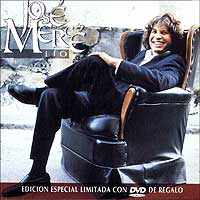| [an error occurred while processing this directive]

|
Flamenco February 2004
The timing is almost perfect: it gives us enough time to recover from Holiday shopping debt to buy our tickets. :) TIP: keep your eyes and ears open. Last-minute workshops with visiting artists are usually scheduled the day of their concert or the day after. Also, serious flamenco freaks will want to buy tickets for the New York Flamenco Festival which happens around the same dates:
Allow me to digress for a moment to talk about business. It seems that shows featuring dancers almost always sell more tickets than those that present little or no dancing i.e. cante concerts. As you know, flamenco began with that powerful and emotion-filled art form known as cante and you'd think the DC general audience would therefore flock to cante concerts. Still, Enrique Morente's DC debut in November was cancelled. Carmen Linares' concert last month only filled half the auditorium (though the audience made up for it with enthusiasm). I hope that the upcoming concert by Jose Merce, often described as "Spain's hottest singer," helps to improve this situation. Kudos to Rosanna Ruscetti, director of Lisner, and Miguel Marin Productions for giving cante concerts an opportunity for the past several years. Ditto for Rosanna's hardworking marketing associate Carl Graci for keeping me informed of upcoming concerts. The DC area is not alone. In the past few years, I know of concerts by other flamenco singers in other parts of the USA that have been cancelled due to low ticket sales. Sad but true: generally speaking, in the USA, dance and guitar concerts sell better than shows highlighting cante. Moving on...by coincidence or for practical marketing reasons, a number of other venues present flamenco shows and workshops around the same time as Lisner's annual Flamenco Festival:
I'm pretty sure, that Paco de Lucia's concert at the Warner Theatre will sell out. I encourage you to attend Paco Peña's Misa Flamenca at Montgomery College. The last time Misa was performed in the DC area was 1994 at Lisner Auditorium--who knows when you'll be able to see it performed again soon? And let's not forget about our local performers: Ziva's Spanish Dance Ensemble at the Corcoran, Richard Marlow and Edwin Aparicio in the John E. Marlow Guitar Series. Years ago, before Lisner's Flamenco Festival became a tradition, the artists' international tour managers consulted the DC Flamenco website and used it as one of the information sources that helped them ascertain what an active flamenco community we have here and decide, "Let's put on a flamenco festival in DC." I can still remember when I had email conversations with producer Miguel Marin when he was inquiring about DC venues for flamenco concerts. Now that we have a flamenco festival every year and an active local flamenco community, let's help keep it growing by supporting your local established and upcoming performers now and year round. Last year, at one of the flamenco festival post-concert parties, some of the visiting artists commented on the DC flamenco community: "They have it!" Of course, we love the fact that internationally well-known flamenco artists are coming to the DC area on a regular basis now, but concerts cost money so it really boils down to whether or not they can sell enough tickets to at least break even.* Let's show these tour managers and concert presenters that DC is a worthwhile city to present a flamenco concert. How do we accomplish this? Buy tickets for yourself and encourage as many of your friends to give flamenco a try and buy tickets to as many of these concerts as they can. TIP: flamenco concert tickets make a great holiday gift! (* Corporate sponsors also do a big part in financially supporting these concerts.) Do you have any further thoughts on this topic? Go to the message board. Bailes Inéditos[Editor's note: this article is from 2003. The location for the November 20-21, 2004 performance is at the Alden Theatre in McLean, Virginia.] Thursday November 13, 2003 Local dancers Edwin Aparicio and Anna Menendez are collaborating for the first time in Bailes Inéditos, a full-length production with new original material that premieres at 8pm on Saturday November 22 and 8pm Sunday November 23, 2003. The performances will take place at the Jack Guidone Theater at the Joy of Motion studios in Friendship Heights 5207 Wisconsin Ave NW DC (1 block south of Bambule). It's an intimate space, which is good because the audience will be close to the performers, but it also means that with such a small seating capacity, it will sell out very quickly. Do yourself a favor and reserve your tickets now ($20 General, $18 Students) and arrive early to snag the best seats. I interviewed Edwin and Anna a few weeks ago. Here's what they had to say: What do you mean by the title Bailes Inéditos? 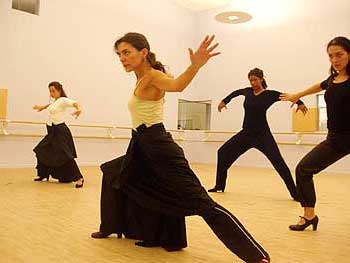 Anna: We are non-Spaniards. We are Hispanic Americans. We both have different backgrounds. But the literal meaning of Bailes Ineditos is unedited dance Unedited dance meaning: this is us at this moment, in this place, at this time and this is what we have to show and to offer. That’s what we mean by Bailes Ineditos. We don’t mean flamenco puro. We don’t mean puro anything. We simply mean: this is us, we are ourselves, and we are showing what we have at this moment and time. As dancers what will distinguish your performance and material in Bailes Inéditos from what we would see in one of the local tablaos? 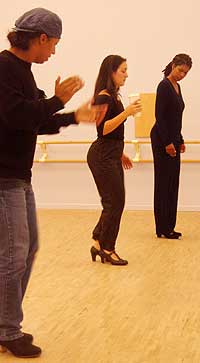 Edwin: This is a different show. This is more of a production than your typical show. We are having a singer and that right there is different. We are also having a few new choreographies that we haven’t presented anywhere else and that guitarist Richard Marlow helped us with the music. Dancers Marta Chico Martín, Sara Jerez and Lisa Scott are also helping us with the project. If you mean us as individual soloists, I think that there might be a few surprises. Anna: This is the first time we have collaborated. This is the first time that we had to share the responsibilities of having to create a full-length production. Edwin: Another thing is that this show doesn’t mean the beginning of a new company. It’s just a project that Anna and I decided to do. We thought that it was the right moment and so we did it. This will not turn in to the Edwin and Anna dance company, although it sounds nice, but not now. Maybe in the near future. I think that it might be too soon for that. What made you decide to hire singer Jesús Montoya? Edwin: I had heard him before in Chicago with Omayra Amaya and Chuscales. He has a nice voice and I liked the way that he sang. I came back to DC and mentioned it to Anna and we decided that he was the right one for the show. Besides being a good singer he has strong palmas. [laughs] That’s a key factor for recent performances. Right now you are creating choreography and rehearsing without a singer. Do you have particular letras in mind when you choreograph? Anna: We have the flexibility to know that if the singer feels strongly about not singing a particular letra that the choreography will still work with any other letra that he sings. That’s my perspective. Edwin: For group numbers, you need to go into the dance studio with the length of popular letras in mind. When I choreograph I always have the singing in mind not only because I love it but because it makes life simpler. The reason for that being is that when the singer shows up for rehearsals, sometimes the day of the show, you don’t want things to go wrong, especially when you are working with a group of four or more dancers. I think that if you are going to put on a show, that you would have some understanding of basic cante that you can work with. If you don’t things might be a bit complex when the singer shows up. Anna: Right. For Bailes Inéditos, the singer only comes two days before the show. And when we’re working with him on our solos, it may be that he says to one of us "Oh, I’m going to try this new letra for your solo," and even though it might be like "Oh my God, I already had everything worked out," you have to open yourself up to be like "OK. Great. Let’s do it." And you meet in the middle somewhere because that’s the exciting thing about having a singer. Edwin: Yeah, but for the most part, like I said before, you need to go in with the singer and the dancers in mind. I think that for soloists is different. Anna: It’s more collaboration between singer and soloist. 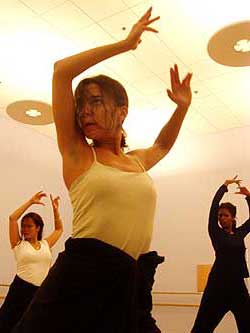 Edwin: Right. Anna: The hour or two that we each get with the singer is our time to set our solos with him. So if he says "I want to sing this letra," this is the time to work it out. Edwin: I think that with soloists it is a different thing. I think that it is your own interpretation of what cante means to you and what your understanding of it is. I think that in order to be a soloist you need to have this concept clear. This only goes for professional dancers. Anna: For the soloists there’s more room for improvisation but as a group number they need to be in sync. It has to be more choreographed. With the soloists you have more room to play. Is this the beginning of an independent dance company? Anna: I’m not thinking to myself, "OK. I’m going to start a company right now," because I don’t know everything and I’ll never know everything. I feel like I need to have vast more experience before I’m in charge of a whole company. It’s much easier to collaborate with one or two people right now than it is to be in charge of a company of 10 or 12 people. I’m more interested in going places and working with people who are better than me to learn from them and experience that. Edwin: Although I have some ideas, I don’t think that I’m ready to lead a company. I think that that is a big responsibility that I’m not ready for. Anna: That’s why the title of Bailes Inéditos is appropriate because this is who we are at this moment. It doesn’t mean we are the masters of flamenco... Edwin: It doesn’t? [laughs] Anna: It means we are good dancers. We are being honest and we’re being ourselves and that’s really the important part of flamenco, so in a way it comes around full circle. So you want to play for dance classes?Monday September 1, 2003 September's here which means that most of the dance teachers are about to start their Fall classes. This is usually a good time for aspiring flamenco dance accompanists to get started playing for classes. 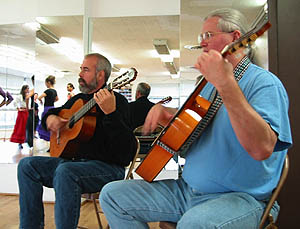 Why? Coming in the middle of the semester might be a little awkward: the dance students have already learned a good chunk of choreography or technique exercises to a set piece of music. Struggling to figure out what to play on your first day while the dance class waits for you is not a good way to get started. I was planning to write a longer article about dance accompaniment. But when I asked a few local dance teachers for some quotes on this topic, they sent me a lot more than that. Oh well, it makes my job easier. My thanks to Natalia Monteleon, Nancy Heller, Aleksey el Rusito and Anna Rubio. (I've included their telephone numbers in case you want to call them about playing for dance classes.) Natalia Monteleon (301-617-0694), who teaches at her home studio in Laurel, Maryland writes: "The first and foremost -- for novitiates. You can't be a complete day #1 beginner and play for dancers. You must have some background first, and it is best if you are studying with a professional flamenco guitar teacher, who can guide you as you proceed. If a beginner guitarist would like to learn to accompany, it's fine to start with a beginner level dance class. Don't try a midlevel or advanced class unless there is a professional level guitarist playing, and then be content to play '2nd fiddle'and take his/her advice. Be prepared to play rhythm and chords. Dance classes don't need fancy falsetas, and in fact these can be more of a hindrance than a help. Besides - the guitarist will learn a lot by playing rhythm and watching and listening to the dancers for each tempo change. Falsetas come later. 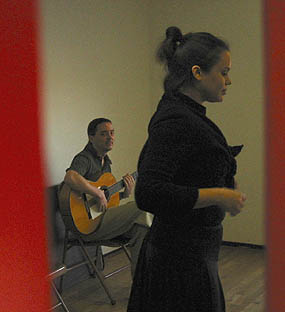 What a dance teacher hates most is for a new guitarist to come in full of things they learned by listening to Paco de Lucía, and then try to play them for class. You may have the technique to play them for your own gratification, but this is not the way to learn to accompany. You can be sure that Paco de Lucía didn't start this way! Remember that the teachers' primary responsibility is to teach the dancers. She/he may be patient and willing to stop every once in awhile when things get too far out of compás. This may be the students' problem, or it may be the guitarist struggling to get it right. Trust the teacher - they are trying to be a conductor and keep everyone together. Once the guitarist is no longer a complete beginner, it is OK to be involved in more advanced classes. Go to your guitar teacher, tell him what the class is working on, they can give you good ideas of falsetas to plug in. But don't be upset if the falseta does or does not go with the series of steps the dancers have. Working on fitting these things together is part of the process. Payment -- well it's like this... Last - Playing flamenco means playing for dance and cante. One might enjoy playing solo guitar and that's fine. However in my book, a flamenco guitarist is one who knows how to accompany, knows the llamadas, desplantes, knows the mood of the palo, is familiar with a good deal of the cante repertoire. Most flamencos will tell you that the most gratifying feeling is playing in a group with dancer, guitar, palmas, and cante (when possible). When it all comes together - the feeling is euphoric. So - please DO make the effort to learn - it's great!" Next we have Nancy Heller, who teaches in Pennsylvania: "[To the Beginning Accompanist]
[To the Dance Teacher Working with A Beginning Accompanist:]
Aleksey el Rusito (443-414-4727) who teaches at DC Dance Collective: "The 'unsatisfiable' wishes of flamenco dance teachers must feel like quite a mystery to the beginner flamenco guitarists. And, probably, often the information received from a guitar teacher will feel like it contradicts what is taught in a dance class. There is a lot to feel in these mysteries and conflicts and, hopefully, the student-guitarist will be able to channel all of those feelings into creative energy... 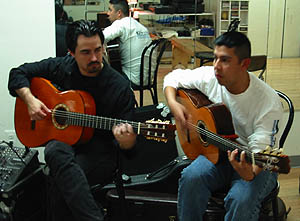 One thing to always remember is that a flamenco dancer (if he/she is good) has a lot to offer to a beginner flamenco musician. Yes, you can offer something to a dance teacher, too, but before you have to learn a lot about dance. A good test to check whether you have entered the stage when you are contributing to the class is when the teacher does not look at you when he/she is counting and when he/she does not stop you to explain each and every step and how it fits into the music before having you accompany the students doing the same step. A flamenco dance teacher does want a guitarist in his/her class (yes)! It adds to the learning experience of the students, provides flexibility when teaching and practicing steps, inspires the teacher and the students, and the list continues. But in the beginning, the dance teacher is doing you a favor by letting you play in the class. So, do not get offended if the teacher tells you to stop playing and 'just listen,' asks you to clap, or even if he/she puts on a CD and has you and the dance students listen or practice to a recorded music. It's ok if you do not know something, and if one of the above-mentioned things happens to you, it most likely means that you need to concentrate on learning something you do not know yet. The notion of compás is of extreme importance. Unfortunately many guitar teachers do not emphasize it enough. In fact, you can probably get away with not playing in compás in a flamenco-illiterate crowd. However, it would be much harder to accomplish if you are accompanying a dancer. Compás will be the foundation, on which you and the dancer (and a singer if you are lucky to have one) will build your beautiful palace for 'el duende.' That is why, one of the main skills you are acquiring in a flamenco dance class is how to support the dancer rhythmically. Supporting the dancer melodically, whatever that entails, is a much harder task and can be learned only with a good and experienced dancer (of which there are not as many as one may think). It is important to understand that acquiring the skill of the melodic support cannot and will not be successful without having the compás down first. Respect is of utmost importance. Hopefully, both you and the teacher will show all due respect to each other and, what is of equal if not greater importance, to the art of flamenco. Most of the respect laws and regulations are intuitive. However, remember that in that class you are a student, and the dance teacher is your teacher, too. Therefore, sometimes you will simply have to keep your hard feelings to yourself or discuss them with the teacher (at your own risk :) ) one-on-one after the class." Finally, we have Anna Rubio who teaches in Philadelphia (215-218-7269) "I don't think of a guitarist as a Flamenco Guitarist unless they can accompany (in my humble opinion). What defines flamenco is the connection of the artists to the compás, as I have said before; flamenco is an individual artform, but it is a group experience. And sitting in class playing for dancers is the only way to learn, first sitting next to a more experienced player and then by yourself. My husband plays for all my classes and what I notice invariably happens is; the student guitarists spend all their time looking at his hands instead of watching how he responds to me teaching or the students dancing. Fortunately for them, Tito is a wonderful teacher as well as an amazing guitarist, and he always works hard to show them and tell them WHY he is doing what he is doing and trying to get them to look at ME and not his hands. I can understand that when you are studying guitar and spending hours and hours by yourself playing it is easy to lose sight of the Big Picture..the interplay between the artists, not just the beautiful falseta! Because of the way Tito teaches the guitar students at the same time as accompanying my classes, it has happened that guitarists want to sit with him as a way of having a free class. Our policy is that these people have to pay to sit in my class with him (and they get their money's worth). Any student of his who sits in my class doesn't pay, Tito decides whether they can play or just do palmas. BUT I always pay any guitarist who plays for my class without Tito, even if they are struggling through the class, because they are doing a job. I believe this job deserves respect, just as my job deserves respect." There you have it. These are just four views on the topic, but it's enough to give you some idea of what the dance teachers generally have in mind when working with live dance accompaniment in class. So if you think you're ready to get started, contact one of the dance teachers listed in my teachers page and find out when classes begin. Good luck! Previously published articles on this topic, from the guitarist's point of view: Introducing, John Fowler...Monday August 11, 2003 Over the years, I've had the pleasure of seeing my website help former DC flamencos from long ago reconnect with the local community. John Fowler (pictured below), a guitarist who was active in the DC flamenco scene in the 60's and 70's, writes: 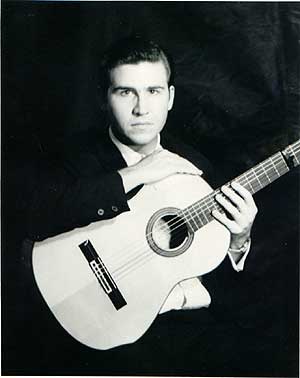 "Michael, I ran across a web page of yours dealing with Manolo Leiva which discussed a record he made some time ago with Juan García de la Mata, Pepa Reyes, and Angel Mancheno. There was also passing mention of a couple of other records on which Manolo appeared. I thought you would like to know of two others, in case you are not already aware of them." "He recorded with the legendary Sabicas on the album 'Day of the Bullfight' (ABC Paramount, ABC-226.5), on which he appears on two cuts (Alegrías and Malagueña). And he recorded with Fernando Sirvent on 'Guitarra Flamenca' (Audio Fidelity AFLP 1896, 1957) along with Pepita and Goyo Reyes; on this one he participates in six of the ten cuts, including the most beautiful Serrana I have ever heard." "I knew Manolo very well back in the 60s and early 70s. I left the D.C. area in 1973 and have been living in the Los Angeles area ever since. I regret not having kept in touch with Manolo, but I had heard that he had moved back to Málaga and presumably retired there. I know he did buy a place on the water near Málaga." "For about eight years before leaving the D.C. area, I played flamenco guitar just about every place it was played there (and a few it shouldn't have been!), including filling in for Carlos Ramos at the Bodegón whenever he was on vacation, not feeling well, or otherwise indisposed. So I accompanied Manolo in hundreds of shows at the Bodegon. He and Carlos were both terrific people and great artists. Carlos made a couple of records, one of which I have: 'El Arte Flamenco' (Spanish Music Center SMC-1004). His playing is wonderful on this album." "I have digitized most of my flamenco albums and applied noise-reduction techniques that have been fairly successful in most cases (pops and clicks are fairly easy to remove, and ordinary surface noise can also be attenuated; attempts to fix distortion from needle gouging are less successful). It is my impression that almost none of the music mentioned above is available commercially, so in principle no copyrights need be violated if you would like for me to send you an MP3 via email, e.g., that Serrana that Manolo sang with Fernando. I suppose you could get Manolo's permission!" "Fernando was also in the D.C. area most of the period I was there. He was with his wife, the terrific dancer Raquel Peña, and at least one daughter whom I tutored in physics in exchange for cante accompaniment lessons with Fernando. His sister, Amor Sirvent, ran a genuine flamenco dance school, which is where I broke in as an accompanist." "Most of my appearances were under the name Juan Halconero. Manolo used to enjoy referring to me as 'Señor Halconero' and was greatly amused one night at the Bodegon when a customer asked him if he was really from Spain. Manolo had trouble convincing him that he was really from Spain, and the same for María del Rocio, who was dancing there at the time. After that, he said to Manolo 'and of course the guitarist is also from Spain I'm sure,' to which Manolo said 'Andalucía!' then turned to me and whispered 'Andalucía, Massachusetts!'." "It's nice to see that flamenco is still thriving in the D.C. area. Regards, John Fowler" I wrote John back informing him that Manolo Leiva is still in the DC area and I mentioned that some of the "old timers" I was going to interview are Natalia Monteleon and Tom Cotton and many more. I asked if he knew these people. "No, those names are not familiar. Some other people who WERE there at the same time that I was and who are still with us (last I heard) are: Paul Heffernan, Torcuato Zamora, and Jorge Strunz. I have not been in touch with Paul or Torcuato for over 20 years, but Jorge is out here in L.A. and has become an extremely successful guitarist. Although he and I played flamenco duets in the old days, he has developed his own guitar style based on his Latin American roots, and we remain close friends. He also paid his dues at El Bodegón and worked extensively with Manolo. In fact he and I played a concert at the State Department auditorium with Manolo and dancers Azucena Vega and Edo Cie, in addition to many other gigs around the area." Yes, the DC flamenco scene has a history and I intend to interview John as well the other old timers who are still in the DC area. In the meantime, John was kind enough to provide me with some photos of DC flamencos in the 60's. [earlier articles][later articles][main index] |
 Saturday December 13, 2003
Saturday December 13, 2003